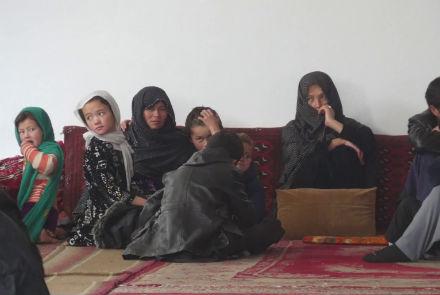Dozens of displaced families, including women and children, who have fled the conflicts in Ghani’s Jaghori and Malistan districts are in Kabul where they are passing difficult times.
Some of the displaced families said they are stationed at mosques in Kabul City and that they are facing numerous challenges in this cold season.
They called on government forces to ensure security of Jaghori and Malistan districts so that they can return to their homes.
Ishaq, a 90 years old displaced man from Malistan, said that this is the first time that he has been forced to leave his home due to insecurity so far.
“I asked my wife to prepare food. After we had the food, we saw that from 20 families in the village, only one family was there and the remaining had left,” said Ishaq.
Farzana, a student from Jaghori, said their school was closed after theclashes intensified in the district. Farzana said they hardly managed to reach Kabul.
“There was no car for passengers. We went from our house to another place and finally reached to Ghazni City. It took two days to arrive in Kabul,” said Farzana.
Hundreds of families from Malistan and Jaghori also have fled to other parts of the country and a big number of them have went to Bamiyan province.
“So far, 900 families have arrived in Bamiyan,” said Zia Rafat, head of Natural Disasters Management Department in Bamiyan.
“We ask President Ashraf Ghani to make Jaghori safe so we can return to our homes,” member of a displaced family said.
“We have lost whatever we had and we ask government to help us,” member of a displaced family said.
Afghanistan National Disaster Management Authority said around 5,000 families have been displaced due to ongoing clashes in Malistan and Jaghori districts in Ghazni and Khas Uruzgan district in Uruzgan province.
Although according to Ministry of Interior, the Army Chief of Staff Gen. Mohammad Sharif Yaftali, Senior Security Deputy for Interior Ministry Gen. Akhtar Ibrahimi and deputy head of the National Directorate of Security with dozens of security forces have arrived in Jaghori and Malistan to launch a large-scale operations, but new reports indicate that fighting has intensified between security forces and Taliban in the districts.
“This action was taken very late. We criticize the delay. Government should have taken action when the clashes started,” Ghazni MP Shah Gul Rezaee said.
Fights in Jaghori and Malistan districts started over a week ago.
UN Paints Grim Picture Of Ghazni Situation
The United Nations Office for the Coordination of Humanitarian Affairs (OCHA) in a report on Wednesday, November 14, said that the situation in Jaghori and Malistan in Ghazni province is “chaotic” and that thousands of families are fleeing the area due to ongoing clashes.
In a news brief on the situation in the two provinces, OCHA said that heavy fighting broke out between the Taliban, supported by some local Pashtun communities, against pro-government Hazara militias in Khas Uruzgan district in Uruzgan province in early November.
OCHA said the tension was initially centered on the villages of Hussaini, Karez and Kondala, but that then the fighting spread to the districts of Jaghori and Malistan in neighboring Ghazni province.
Clashes have escalated since Saturday, November 10, after reinforcement troops and air support were sent in.
OCHA reports that the affected districts are chaotic and that families have been moving repeatedly in search of safety. The organization reports that displaced people are fleeing to Bamiyan and Maidan Wardak provinces and to Kabul.
According to their report, civilian casualty numbers cannot yet be determined accurately but local sources have told them at least 15 civilians were killed in Malistan alone on Sunday, November 11.
OCHA said: “The total number of civilian casualties is likely to be higher.”
The organization also said reports have been received of violations of the International Humanitarian Law, with private houses burnt and civilian vehicles stolen or confiscated.
They said roads connecting Jaghori and Malistan to Ghazni city have reportedly been blocked, which is “preventing safe passage for civilians attempting to leave the area, and leaving people in siege-like conditions with no access to health facilities and limited availability to food, fuel, and medicine.”
“Families abandoning their homes are exposed to harsh winter conditions and in need of shelter and warmth,” they said.
In Ghazni City, Afghanistan National Disaster Management Authority and the department of refugees and returnees registered 1,000 internally displaced families on 11 and 12 November.
The IDPs are living in schools, mosques and homes of local families, OCHA reported.
In Bamiyan Center, officials report that 400 displaced families have arrived but that there are reportedly up to 4,000 families headed towards Ghazni City and Kabul.
OCHA states however that no humanitarian response has been carried out in Jaghori and Malistan as partner organizations have not been able to access the affected population due to the fighting.
They also stated that in Ghazni city, provincial disaster management officials met on Monday and together with NGOs are now leading efforts to assess the situation and identify the needs of the displaced people.
In Bamiyan, organizations have already started to provide non-food items, including warm clothing, to displaced families.


